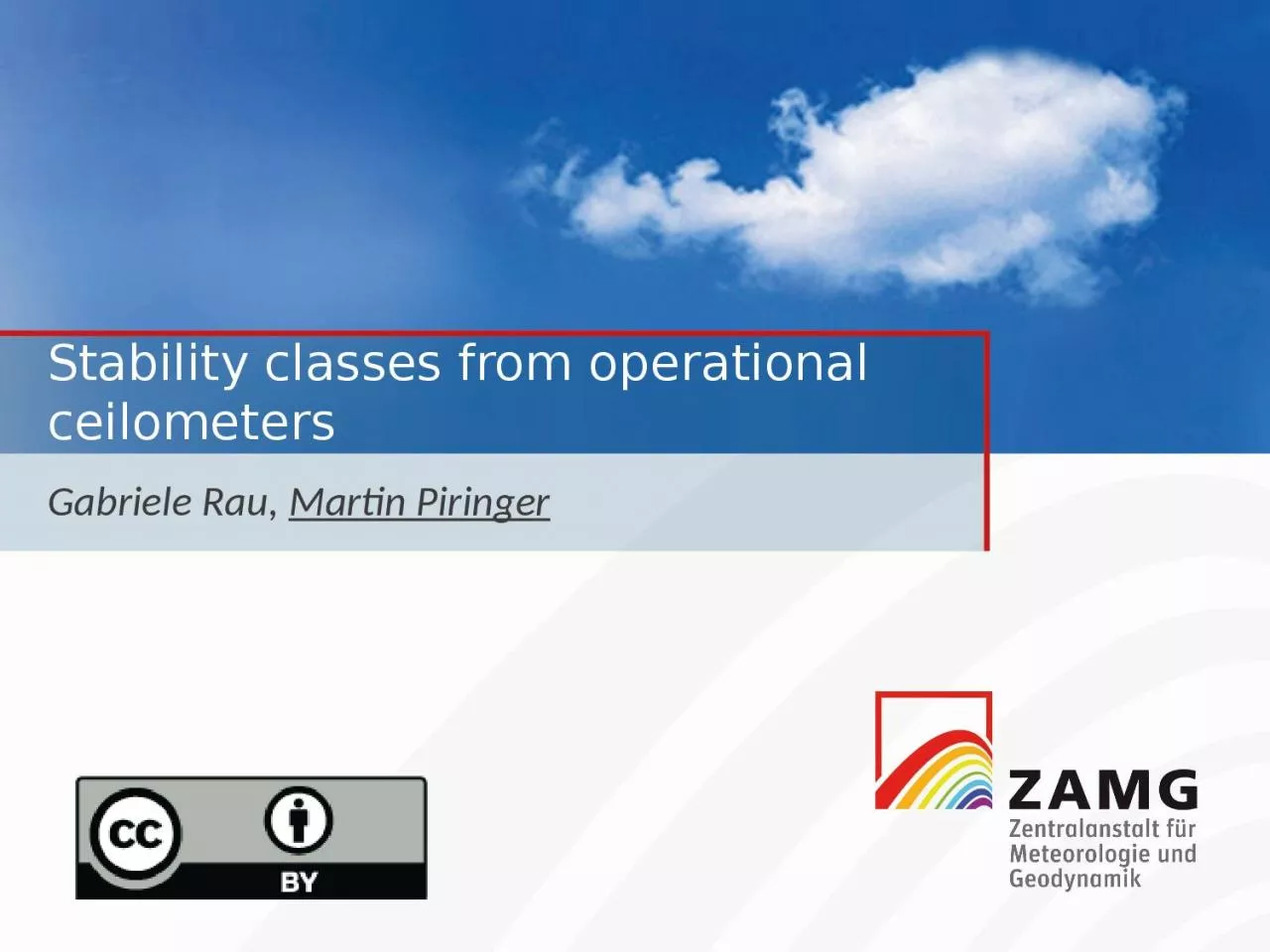

Gabriele Rau Martin Piringer Outline Motivation Stability classes from human cloud cover observations Stability classes from ceilometer using cloud base ID: 1021821
Download Presentation The PPT/PDF document "Stability classes from operational ceilo..." is the property of its rightful owner. Permission is granted to download and print the materials on this web site for personal, non-commercial use only, and to display it on your personal computer provided you do not modify the materials and that you retain all copyright notices contained in the materials. By downloading content from our website, you accept the terms of this agreement.
1. Stability classes from operational ceilometersGabriele Rau, Martin Piringer
2. OutlineMotivationStability classes from human cloud cover observationsStability classes from ceilometer using cloud base height informationResults: Comparison of stability classes Summary of findings21.10.2016Folie 2
3. MotivationDispersion models usually need atmospheric stability information as a meteorological input parameterKlug-Manier scheme used here (German AKTerm-format)Stability classes from cloud coverage data is one of the most often used schemes for the parameterizationThe number of fully automatic meteorological stations (without human observations) is increasingMethods other than human observations to quantify cloud coverage – e.g. based on instruments such as ceilometers –will come into use, despite the different approaches of how to define cloud cover21.10.2016Folie 3CL51 at ZAMG
4. Aim of the investigationA human observer will take into account the whole visible skyA ceilometer can only detect clouds directly above the instrument, but with a high temporal resolutionCan the mean value of ceilometer soundings over a defined period of time (i.e. an hour) be used as a substitute for observed cloud coverage data in order to determine stability classes?At 4 sites in Austria Klug-Manier-classes derived from observed cloud data (for the year 2014) were compared with Klug-Manier-classes from ceilometer dataAt one site (ZAMG at Vienna), a single ceilometer CL51 is in use, at the airports (AustroControl) several (up to five instruments) ceilometers (CL31) can be combined to improve the cloud cover information21.10.2016Folie 4
5. Cloudiness from CeilometersCeilometer does not deliver total cloud cover, but cloud cover from up to 3 single layers where clouds are detected (sky-condition-algorithm of manufacturer)At airports, data of more than one ceilometer can be combined to decrease the effect of a point measurementTwo algorithms for total cloud cover from ceilometers were tested (for CL51 only): Total cloud cover = Max. of observed cloud cover (CeiloMax). This method was used for all further investigations Total cloud cover = Sum of observed cloud cover from all layers (CeiloSum)21.10.2016Folie 5
6. Cloudiness - human observation vs. ceilometer21.10.2016Folie 6Independent of site:Ceilometer over-estimates 0/8 and 8/8 cloudinessCeilometer under-estimates 2/8 to 7/8, partly over- and underestimates 1/8This is a result of observer instructions: 0/8 only, if there is no visible cloud; 8/8 only, if there is no visible cloud-free spaceAmount of agreement: 36 to 40 %; +/- 1 okta: ~ 70 %
7. Definition of Klug-Manier stability classesKlug-Manier classes are numbered from I to V and are classified according to atmospheric stability as follows:Stability classes V and IV comprise very unstable and unstable conditions, meaning good vertical mixing in the boundary layer. They do not occur during night-time. Class V occurs only between May and September.Stability classes III/2 and III/1 are classified as neutral. III/2 occurs predominantly at daytime, III/1 predominantly at night-time and during sunrise and sunset. These classes are typical for cloudy and/or windy conditions.Stability classes II and I comprise stable and very stable conditions, mostly, but not exclusively at night. They occur with reduced vertical mixing; horizontal transport over long distances is possible.21.10.2016Folie 7
8. Basic scheme to determine Klug-Manier stability classes21.10.2016Folie 8For *), **) and ***) several additional rules apply. Depending on the season a variety of further adaptations have to be considered.The stability class is determined for each hour via wind speed, cloud cover,base height of cloud as well as month and daytimeLow wind speed, low cloud cover: stable during night, unstable during daytimeHigh wind speed, high cloud cover: neutral day and night
9. Results: comparison of stability classes for Vienna21.10.2016Folie 9Agreement observation to ceilometer: 84% (ZAMG) to 86.6 % (Airport)
10. Results: comparison of stability classes for Linz21.10.2016Folie 10Agreement observation to ceilometer: 86.2%
11. Results: comparison of stability classes for Salzburg21.10.2016Folie 11Agreement observation to ceilometer: 88.1%
12. Details of the comparison I21.10.2016Folie 12Upper table: Vienna/ZAMG, one ceilometer CL51Lower table: Vienna/Airport, several ceilometers CL31Causes of good agreement: cloudiness and wind speed are split into only a fewclasses, wind speed data are the same
13. Details of the comparison II21.10.2016Folie 13Very good agreement for the airports at Linz (upper table) and Salzburg (lower table)
14. InterpretationA good agreement between stability classes from visual cloudiness observations and ceilometer-derived cloudiness is obtainedIn 84 to 88 % of all cases, the same stability class is determinedThe agreement of stability classes is better than that of the cloud informationThis result is to be expected as the cloudiness and wind speed data are summarized to only a few classesCeilometer cloud information can be used equally well as visual observation to determine stability classes21.10.2016Folie 14
15. 21.10.2016Folie 15Thank you for your attention!Questions?